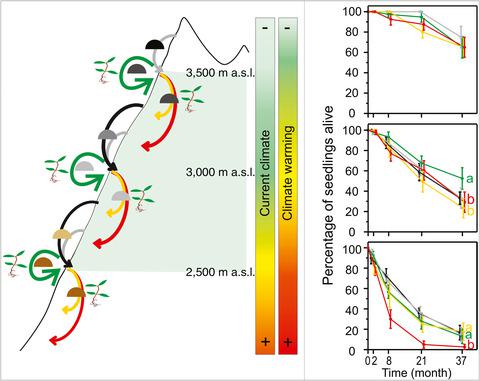Our official English website, www.x-mol.net, welcomes your feedback! (Note: you will need to create a separate account there.)
Multi‐population seedling and soil transplants show possible responses of a common tropical montane tree species (Weinmannia bangii) to climate change
Journal of Ecology ( IF 5.5 ) Pub Date : 2020-05-30 , DOI: 10.1111/1365-2745.13443 Richard Tito 1, 2, 3 , Heraldo L. Vasconcelos 1 , Kenneth J. Feeley 2
中文翻译:

多种种群的幼苗和土壤移植表明一种常见的热带山地树种(Weinmannia bangii)对气候变化的可能响应
更新日期:2020-05-30
Journal of Ecology ( IF 5.5 ) Pub Date : 2020-05-30 , DOI: 10.1111/1365-2745.13443 Richard Tito 1, 2, 3 , Heraldo L. Vasconcelos 1 , Kenneth J. Feeley 2
Affiliation

|
- A possible response of many plant species to global warming is migration to higher elevations. However, these migrations may not be required if species can tolerate higher temperatures, or may be prevented if there are other factors such as changes in soil conditions that make upslope areas unsuitable.
- We used a set of 3‐year field transplant experiments in the remote Peruvian Andes to simulate two possible responses of an abundant tropical montane cloudforest tree species (Weinmania bangii) to global warming: (a) ‘upward migration’, in which case seedlings of W. bangii's were grown at their current elevation/temperature but in soils transplanted from higher elevations and (b) ‘migration failure’, in which case seedlings were transplanted downslope along with their home soils into areas that are 1°C or 2°C warmer. We conducted separate experiments with populations from the upper/leading edge, middle and lower/trailing edges of W. bangii's elevational/thermal range to assess the influence of local adaptation on responses to changes in temperature or soil.
- We found that seedling survival and growth were not affected by changes in soil conditions, regardless of the origin population. However, seedling survival decreased with temperature. A simulated warming of 1°C caused a significant reduction in the survival of seedlings transplanted from the mid‐range population, and 2°C warming caused a severe decrease in the survival of seedlings transplanted from both the mid‐range and bottom‐edge populations.
- Synthesis. Our findings reveal that rising temperatures are a serious threat to plants, especially in populations growing in the hotter portion of their species’ range. At least in the case of W. bangii, novel soil conditions will not limit the establishment or growth of seedlings at higher elevations. As such, decreases in the survivorship at lower elevations may be offset through upward migrations as temperatures continue to increase.
中文翻译:

多种种群的幼苗和土壤移植表明一种常见的热带山地树种(Weinmannia bangii)对气候变化的可能响应
- 许多植物物种对全球变暖的可能反应是向更高海拔的迁移。但是,如果物种可以忍受较高的温度,则可能不需要这些迁移;如果存在其他因素(例如,土壤条件的变化导致上坡区域不合适),则可以阻止这些迁移。
- 我们在偏远的秘鲁安第斯山脉进行了为期3年的田间移植实验,以模拟丰富的热带山地云杉树种(Weinmania bangii)对全球变暖的两种可能的响应:(a)“向上迁移”,在这种情况下为邦吉W. bangii's在当前的海拔/温度下生长,但在从较高海拔移植的土壤中生长,并且(b)“迁移失败”,在这种情况下,将幼苗连同其家中土壤一起下坡移植到1°C或2°C的区域温暖。我们对邦氏W.海拔/热量范围的上/前缘,中/下/后缘的种群进行了单独的实验,以评估局部适应对温度或土壤变化的响应的影响。
- 我们发现,无论原始种群多少,幼苗生存和生长都不受土壤条件变化的影响。然而,幼苗存活随温度降低。模拟的1°C升温导致中距离种群移植的幼苗存活率显着降低,而2°C升温导致中距离种群和底缘种群移植的幼苗存活率严重降低。
- 综合。我们的发现表明,温度升高对植物构成严重威胁,特别是在物种范围较热部分中生长的种群中。至少在班氏W.的情况下,新的土壤条件不会限制高海拔地区幼苗的建立或生长。因此,随着温度的持续升高,低海拔地区的生存率下降可能会通过向上迁移来抵消。


























 京公网安备 11010802027423号
京公网安备 11010802027423号